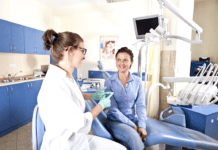Dental providers have been talking about oral-systemic health for many years. Some may feel it falls on deaf ears, but they fight the good fight.
Organizations such as the American Academy of Oral Systemic Health feature a bountiful array of continuing education classes speaking about the relationship between oral health and whole-body health. You can dial up courses on the relationships between oral health and cardiovascular disease, diabetes, cancer, sleep, gut health, dementia, and pregnancy at virtually any moment.
What we are not easily finding is locating the number of groups outside our “bubble” that are doing remarkable things to push the oral-systemic cause forward. Medicine and dentistry are divided due to history, inadequacies in interdisciplinary education, funding, and disparities in care models. There are groups, however, who are furthering the advancement of oral-systemic health care, policy, and uniting disciplines. As a result of some opportunities, I have developed relationships with not only dentists but physicians, nurse practitioners, and social workers who are pushing for collaboration and integration between disciplines that many of us may not know about.
Breaking down walls between medicine and dentistry that are so firmly erected is not simple. Policy must change in order to utilize our knowledge of oral-systemic health effectively. That could be better oral health equity to include dental benefits to more people within the Medicare and Medicaid framework. We could also advance teledentistry or change laws so that dental hygienists would be allowed to work inside medical practices and hospitals.
Both dental and medical professionals need to know what other groups are ushering conversations and how they can help move the needle for the oral-systemic mission. One of those groups leading the charge is the Santa Fe Group.
Santa Fe Group
The Santa Fe Group was established more than 25 years ago and is a 501(c)(3). They are an “action-oriented think tank with a passion to improve lives through oral health.” The Santa Fe Group has been a group of people connecting, communicating, and a catalyst to “move the needle on critical issues such as oral cancer, dental education reform, children’s oral health, improved primary care access, the importance of linking medical and dental health systems, and most recently, expanding oral health care for our nation’s seniors.”
Dental Hygiene Not on the List?
The group’s members include accomplished dentists, physicians, nurses, public health advocates, business leaders, and scholars, as listed on their website. You do not see dental hygienists on the list. So, I contacted the organization to get a little bit more information. I was confused because they support us and our skills as well as advocate for our advancement.
My interaction began with Martha Somerman, DDS, Ph.D., whom I knew was involved to a degree with the group. That led to an email correspondence with Teresa Dolan, DDS, MPH, who is the president-elect of the Santa Fe Group. Dr. Dolan wrote, “We had a discussion at last week’s Continuum planning committee meeting about ensuring broad representation of disciplines and perspectives in the Continuum, including that of ADHA and the dental hygiene community. Dr. Hannah Maxey served as reactor for the third webinar, Learning from Health System Initiatives: What can be done to scale up integration? and she provided great feedback and suggested action steps during her remarks and Q&A.”
The Continuum provides education and professional development through webinars, white papers, and editorials. Through the most recent webinar, Hannah Maxey, RDH, Ph.D., MPH, was on the panel discussing her thoughts and direction for oral-systemic integration.
Dr. Maxey is a force that literally blew me away. She is an assistant professor and director of Bowen Center for Health Workforce Research & Policy at Indiana School of Medicine. The center is involved in health workforce policy and research on not only the state but also the national level. Her recent work reviews the effect of state regulation of the dental hygiene workforce in underserved communities. She currently focuses on assessing workforce models that support the integration of oral health with primary care.
To have her as a champion for hygienists, in my opinion, is a coup. I believe that a dental hygienist will become a member of the Santa Fe Group at some point very soon.
The Origin of Sante Fe Group
Five doctors initiated a think tank or policy institute to discuss the future of health care, focusing on oral health, dental education, and research. Drs. Larry Meskin, Dominick DePaola, Michael Alfano, Harold Slavkin, and Arthur Dugoni began with a center of early and effective oral cancer detection, which started to change the cancer diagnostic model. The Oral Cancer Consortium, a group of 35 institutions, was created, conducting free annual oral cancer screenings and “Oral Cancer Walkathons.”
Santa Fe’s work includes expanding Medicare, improving children’s health, reforming health education, innovating health care, and increasing access to care. The organization’s website outlines its vision for critical issues in oral health as described below:
Foster Health Leadership
- Enhance leadership development in health sectors.
- Challenge leaders to propose system innovations to eliminate health disparities and ensure equitable access to health and well-being.
- Expand partnerships with external stakeholders to advance medical-dental integration.
Achieve Oral Health Equity
- Promote oral health literacy of the public, providers, policymakers, payors, and philanthropy.
- Advocate to address the social determinants that support health and well-being.
- Inspire innovation to ensure access to high-quality and cost-effective health care, especially for vulnerable populations.
Transform Oral Health Education & Practice
- Strengthen diversity in oral health professions and access to education and training.
- Promote solutions to address the impending health professions workforce shortage.
- Advance inter-and intraprofessional collaborations to transform health care capacity.
- Explore innovative workforce practice models as opportunities to increase access to health care for all.
- Enhance the role of science in oral health education, practice, and policymaking.
- Champion the dental profession as an interprofessional stakeholder in comprehensive health care delivery.
As with any change, the approach has to be developed and fine-tuned, whether that be through the private sector, education, and/or public partnerships. Public awareness is key for effectiveness, and the Santa Fe Group has a commitment to “unbiased inquiry, to seek answers to a broad range of health-related questions.”
Santa Fe Group 2013 Conference
In 2013, the Santa Fe Group, the ADHA, and the ADHA Institute for Oral Health got together with 100 oral health “stakeholders” for an event held in Chicago. A former president of the ADHA, Denise Bowers, RDH, Ph.D., presided alongside the Santa Fe Group president at the time, Linda Niessen, DMD, MPH, MPP. The Transforming Dental Hygiene Education conference encouraged those in attendance to look at a future with a fundamental shift in how the dental hygiene curriculum could prepare RDHs for an ever-changing health care system.
The curriculum change was in the context of the Affordable Care Act, describing all the barriers that would need to be gotten through. Dr. Claude Earl Fox, a former Administrator of the Health Resources and Services Administration (HRSA) and Santa Fe Group member, explained how attendees could lead the transformation of their own profession. In addition, representatives of nursing, pharmacy, and physician assistants explained how their professions had extended their scopes of practice through innovation and persistent efforts to influence the legislative, educational, and practice environments. An academic white paper that details the proceedings you may access.1
The paper is expansive, but the crux spoke to changes in education to perhaps including interprofessional education, leadership, and remove “topics that are only tested on the national boards, but not clinically relevant. Plan to provide handouts to students on those topics.”
There was a great quote that supported dental hygienists well. Pamela Overman, EdD, RDH, the associate dean for academic affairs at the University of Missouri Kansas City School of Dentistry, said, “We are at a crossroad where suddenly the environment seems ready and willing to foster change. The environment is riper than it has ever been before. Oral health care access is being recognized as a social justice issue, and dental hygienists have an integral role to play in that conversation.”
Santa Fe Group Focus on Seniors
In 2007, the group met to discuss how to best meet the needs of the onslaught of boomers turning 65 and to identify how to improve their oral health. Attendees looked at the evidence for need first and then what exactly Medicare benefits would need to look like. They discussed the rationale, costs, and how oral care would benefit the population.
National oral health leaders and advocates spoke about current and future policy. Some of the leaders included Dr. R. Bruce Donoff, the former dean at Harvard School of Dental Medicine; Mary Foley, executive director of Medicaid Medicare CHIP Dental Services Association; and Marko Vujicic, chief economist at Health Policy Institute, American Dental Association. The 22-page white paper can be found on the Santa Fe Group’s website.
In 2016, the Salon reviewed and discussed evidence about the need for dental coverage for seniors and what a Medicare benefits package could entail. More than 175 health care changemakers met in 2019 from across all sectors to join in one mission to “elevate the critical needs to include an oral health benefit in Medicare.”
The Santa Fe Group has gathered consensus statements on Medicare coverage for medically necessary oral and dental health therapies from over 125 partners, including the American College of Physicians, the National Association of Nutrition and Aging Services Program, AARP, the Parkinson Association, and the American College of Cardiology. The organizations are “proud to join in support of Medicare coverage for medically-necessary oral/dental health therapies.”
In a separate statement, “Clinical Consensus on Medically Necessary Dental Care,” medical groups shared their professional perspective on the importance and relevance of oral health and systemic diseases. The American College of Physicians statement is, “Dental problems, particularly dental infections, pose a major problem for patients with cardiac valvular disease, patients who are immunosuppressed by virtue of underlying disease or immunosuppressive medications, patients with various types of prostheses, and patients who are at risk of aspiration. The implications of dental disease in such patients extend well beyond their oral disease, with potentially life-threatening complications if the dental problems are not treated.”
The statement from the American College of Cardiology is, “The data linking dental infections to increased risk of cardiovascular disease is clear. Severe dental infections can compromise cardiac conditions.”
Santa Fe Group Focus on Pediatrics
Hosted by the University of Southern California School of Dentistry in 2006, the group convened with other professional organizations and businesses to “widen the lens” on children’s health disparities looking at environmental, social, cultural, and biological reasons that impact children’s health and wellness. This did include oral health. An area addressed was dental professionals focusing on improving access to care to reduce oral health disparities, but that single plan won’t eliminate health discrepancies. There must be studies of family and community factors to reduce rising rates of early childhood caries.
They also convened a panel in 2011 to discuss the need to link medical and dental delivery systems specifically for children under the age of three. The panel presented three case studies, including the Washington State Well Baby program, Maine’s Early Childhood Oral Health Initiative, and North Carolina’s Into The Mouth of Babes program. The program were models for the integration of oral health and medical care.
The Santa Fe Group was a collaborating partner in 2016 with Healthy Futures; a group focused on childhood obesity. This served as an important step to involve the oral health community in the prevention of childhood obesity. The agenda included an overview of relevant scientific literature and the identification of evidence-based recommendations and strategies that could be done by oral health professionals and organizations.
One of the speakers was author Donald Chi, DDS, Ph.D., who did a review of 180 studies examining whether non-modifiable and modifiable factors related to childhood obesity can be used by oral health professionals to prevent or manage dental caries in children. His research showed avenues to be used to develop interventions and programs to prevent caries and obesity in children.4
Santa Fe Group Continuing Education
You can currently receive some of the best continuing education I have seen to date related to health integration. There are webinars, white papers, editorials, and resources that will culminate in a Salon titled The Benefits of Integrating Oral Health into Healthcare on September 8-9. This year’s event will be virtual but no less impactful.
This year’s webinars, which began in March, consist of a total of six and are absolutely free. You can access on-demand or watch live through their website. They often showcase what is being done in the medical and dental fields. I learned most recently about Patricia Braun, MD, MPH, FAAP, who is leading the evaluation of the Colorado Medical-Dental Integration Project that integrates dental hygienists onto health care teams in medical clinics throughout the state. The patients who are visiting their doctor will be able to see a dental hygienist that will help families with limited access to dental care.
Dr. Braun also is involved in the SMILES Dental Project that creates opportunities for Coloradans to get the dental care they need by reducing or eliminating barriers to care through integrating dental hygienists into community spaces across Colorado. I also heard about Michael Helgeson, DDS, who was one of the founders of Apple Tree Dental, a nonprofit that operates eight centers for dental health and delivers on-site care in collaboration with more than 145 urban and rural organizations.
It has been over 20 years since the US Surgeon General identified oral disease as a priority health concern, and frankly, too little progress has been made. The separation of the mouth and body is engrained in medicine and dentistry for generations by separating education, professional organizations, payment structures, and delivery systems.
The pervasive oral health disparities for low-income, minority, rural, and other underserved populations are significant, and the Santa Fe Group addresses these issues. There are an array of resources and opportunities to learn from not only with The Santa Fe Group but countless other organizations. It takes all of us sharing, communicating, and collaborating not only for integration with medical colleagues and systems but within our dental groups.
“By working together, pooling our resources and building on our strengths, we can accomplish great things.” – Ronald Reagan
Need CE? Check Out the Self-Study CE Courses from Today’s RDH!
Listen to the Today’s RDH Dental Hygiene Podcast Below:
Santa Fe Group References
- Transforming Dental Hygiene Education and the Profession for the 21st Century. (2020, June). American Dental Hygienists’ Association. Retrieved from https://santafegroup.org/wp-content/uploads/2020/06/transforming-dental-hygiene-education-a-white-paper.pdf
- Santa Fe Group. Retrieved from https://santafegroup.org
- Connecting Coloradans to Oral Health Care. (2021). SMILES Dental Project. Retrieved from https://smilesdentalproject.org
- Chi, D.L., Luu, M., Chu, F. A Scoping Review of Epidemiologic Risk Factors for Pediatric Obesity: Implications for Future Childhood Obesity and Dental Caries Prevention Research. J Public Health Dent. 2017 Jun; 77(Suppl 1): S8-S31. doi: 10.1111/jphd.12221. Epub 2017 Jun 10. PMID: 28600842.











